Engraved striking Alarm Carriage clock, Drocourt

This is a pristine example of a newly regilded engraved carriage clock by a highly esteemed maker of the 1880s.
The gold-plated Cannelée-styled is engraved with a well defined floral pattern, the one piece handle one-way folding handle with a geometric pattern. The oval glass top and all four sides have perfect beveled glasses.
The 8-day movement strikes the hours and the tasing of the half hour. It repeats the last hour on depressing the button on the top of the case. The original silvered platform has an angled two-part bridge. The wheel crossings are all straight, and the gong black is signed F.D. It strikes on a coiled gong, giving a mellow sound, with a separate hammer for the alarm.
The perfect white enamel Roman dial has delicate steel moon-style hands. Below it is an alarm dial with Arabic numerals. Both are set into a gold-plated well-engraved mask.
The movement is typical of the work of Alfred Drocourt from this period. The backplate is stamped with Drocourt’s trademark, and with the serial number 10491. This number is repeated on case parts and the front-plate. Also on the front plate is the stamp for HL, and their serial number 19707. H.L. were the supplier of their blanc roulants, or unfinished movements, workshops later incorporated into Drocourt’s own.
Pierre & Alfred Drocourt were among the top makers of carriage clocks in the mid to late Victorian period, having a factory at Saint-Nicolas-d’Ailermont in France, and in Paris at Rue Debelleyme 28 and Rue de Limoges.
Pierre & Alfred Drocourt made superb carriage clocks that were often decorative and were awarded numerous medals at exhibitions, such as the Bronze Medal at Paris 1867, the Silver at Paris 1878 and the gold at Paris in 1889.
The son, Alfred Drocourt, succeeded his father Pierre Drocourt sometime in the 1870s.
Leigh Extence has carried out considerable research into the life and works of Drocourt, and this clock is identical to serial number 11404, as detailed in several places in his 2014 catalogue.